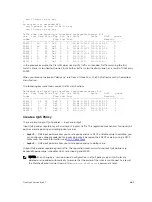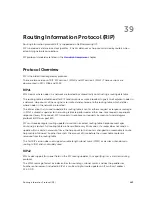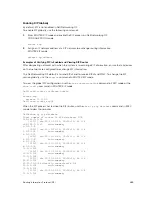
achieved. Also, the devices can respond to congestion before a queue overflows and packets are
dropped, enabling improved queue management.
When a packet reaches the device with ECN enabled for WRED, the average queue size is computed. To
measure the average queue size, a weight factor is used. This weight factor is user-configurable. You can
use the
wred weight number
command to configure the weight for the WRED average queue size. The
mark probability value is the number of packets dropped when the average queue size reaches the
maximum threshold value.
The weight factor is set to zero by default, which causes the same behavior as dropping of packets by
WRED during network loads or also called instantaneous ECN marking. In a topology in which congestion
of the network varies over time, you can specify a weight to enable a smooth, seamless averaging of
packets to handle the sudden overload of packets based on the previous time sampling performed. You
can specify the weight parameter for front-end and backplane ports separately in the range of 0 through
15.
You can enable WRED and ECN capabilities per queue for granularity. You can disable these functionality
per queue, and you can also specify the minimum and maximum buffer thresholds for each color-coding
of the packets. You can configure maximum drop rate percentage of yellow and green profiles. You can
set up these parameters for both front-end and backplane ports.
Global Service Pools With WRED and ECN Settings
A global buffer pool, whichis a shared buffer pool accessed by multiple queues when the minimum
guaranteed buffers for the queue are consumed, can be configured on the Z9000 platform.
Support for global service pools is now available. You can configure global service pools that are shared
buffer pools accessed by multiple queues when the minimum guaranteed buffers for the queue are
consumed. Z9000 platform support four global service-pools in the egress direction. Two service pools
are used– one for loss-based queues and the other for lossless (priority-based flow control (PFC))
queues. You can enable WRED and ECN configuration on the global service-pools.
You can define WRED profiles and weight on each of the global service-pools for both loss-based and
lossless (PFC) service- pools. The following events occur when you configure WRED and ECN on global
service-pools:
• If WRED/ECN is enabled on the global service-pool with threshold values and if it is not enabled on
the queues, WRED/ECN are not effective based on global service-pool WRED thresholds. The queue
on which the traffic is scheduled must contain WRED/ECN settings, which are enabled for WRED, to
be valid for that traffic.
• When WRED is configured on the global service-pool (regardless of whether ECN on global service-
pool is configured), and one or more queues have WRED enabled and ECN disabled, WRED is
effective for the minimum of the thresholds between the queue threshold and the service-pool
threshold.
• When WRED is configured on the global service-pool (regardless of whether ECN on global service-
pool is configured), and one or more queues are enabled with both WRED and ECN, ECN marking
takes effect. The packets are ECN marked up to shared- buffer limits as determined by the shared-
ratio for that global service-pool.
WRED/ECN configurations for the queues that belong to backplane ports are common to all the
backplane ports and cannot be specified separately for each backplane port granularity. This behavior
674
Quality of Service (QoS)
Summary of Contents for Z9000
Page 1: ...Dell Configuration Guide for the Z9000 System 9 7 0 0 ...
Page 80: ...grub reboot 80 Management ...
Page 128: ... 0 Te 1 1 Te 1 2 rx Flow N A N A 128 Access Control Lists ACLs ...
Page 491: ...Figure 70 Configuring OSPF and BGP for MSDP Multicast Source Discovery Protocol MSDP 491 ...
Page 496: ...Figure 73 MSDP Default Peer Scenario 1 496 Multicast Source Discovery Protocol MSDP ...
Page 497: ...Figure 74 MSDP Default Peer Scenario 2 Multicast Source Discovery Protocol MSDP 497 ...
Page 498: ...Figure 75 MSDP Default Peer Scenario 3 498 Multicast Source Discovery Protocol MSDP ...
Page 760: ...Figure 100 Single and Double Tag TPID Match 760 Service Provider Bridging ...
Page 761: ...Figure 101 Single and Double Tag First byte TPID Match Service Provider Bridging 761 ...






























